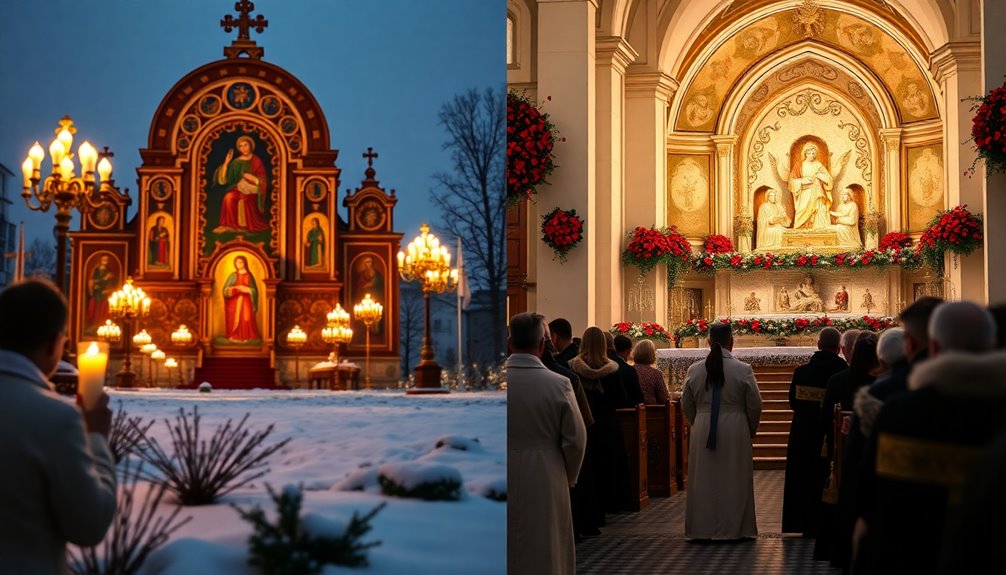Orthodox Christmas and Catholic Christmas differ mainly in dates and traditions. You'll find Orthodox Christians celebrating on January 6 and 7, while Catholics mark December 25. The celebrations also vary; Orthodox people fast on Christmas Eve until the first star and enjoy traditional meals, often with 12 dishes. Catholics typically gather for three masses and focus on festive meals with fish and vegetables. Gift-giving also shifts; Orthodox gifts often come on St. Nicholas Day or New Year's Eve, while Catholics exchange gifts on Christmas Day. Curious about the deeper meanings behind these traditions? There's more to explore!
Key Takeaways
- Orthodox Christmas is celebrated on January 6 and 7, while Catholic Christmas is on December 25, reflecting different calendar systems.
- Orthodox traditions involve fasting on Christmas Eve and serving 12 dishes, while Catholic customs focus on festive family meals and multiple masses.
- Gift-giving in Orthodox cultures often occurs on St. Nicholas Day or New Year's Eve, while Catholics exchange gifts on Christmas Day.
- Regional variations in customs exist, blending Christian and pre-Christian traditions, such as Ukraine's vertep puppet theater and Bulgaria's water rituals during Epiphany.
- Orthodox Christmas emphasizes spiritual reflection and community, whereas Catholic Christmas highlights family unity and the joy of giving.
Calendar Differences

When it comes to Christmas celebrations, the calendar differences between Orthodox and Catholic Christians are significant.
Orthodox Christians celebrate Christmas on January 6 and 7, following the Julian calendar, which is currently 13 days behind the Gregorian calendar used by Catholics. This discrepancy results in differing dates for Christmas, with most Western Christians observing the holiday on December 25.
Notably, some Orthodox churches, like the Ukrainian Greek Catholic Church, stick to January 7, while others have adopted December 25. By 2100, the Julian calendar will drift further, pushing Orthodox Christmas to January 8.
These calendar differences highlight the historical divergence between Catholics and Orthodox, shaping how each group celebrates this beloved holiday.
Traditional Celebrations
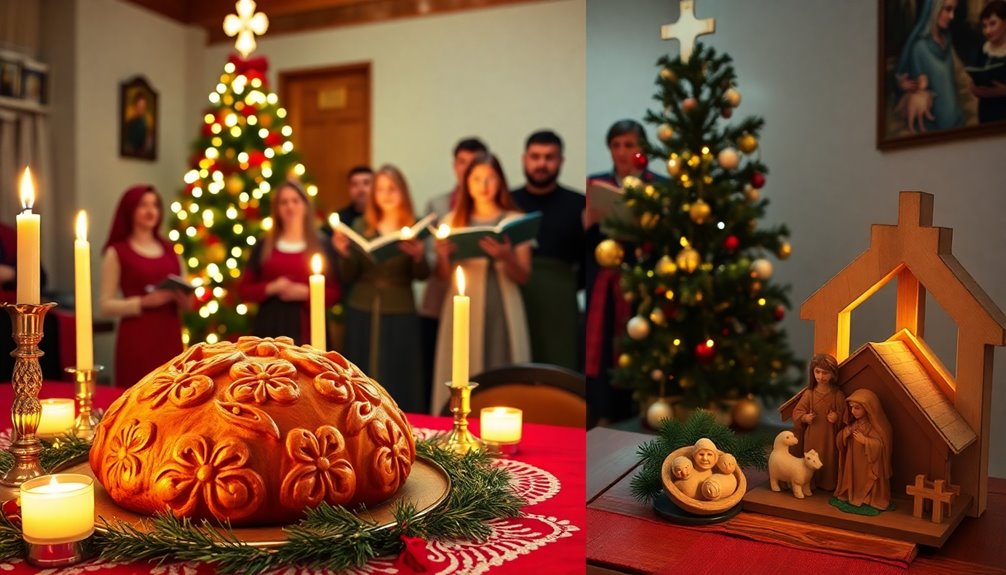
Traditional Christmas celebrations vary greatly between Orthodox and Catholic Christians, reflecting their unique customs and beliefs.
On Orthodox Christmas Eve, you'll fast until the first star appears, symbolizing Jesus' birth, while Catholics generally don't have this practice. The festive meals also differ:
- Orthodox Christians enjoy 12 dishes representing the apostles.
- Kutia, a porridge-like dish, is commonly served.
- Catholics typically have fish and vegetable dishes.
- Their gatherings often include multiple masses.
On Christmas Day, Orthodox believers start with a church visit, followed by a hearty meal with roast meats, emphasizing community and family.
In contrast, Catholics celebrate with a more commercialized atmosphere, focusing on communal family gatherings, showcasing the distinct spirit of each tradition.
Gift-Giving Customs

When you think about gift-giving customs, the timing and cultural influences really stand out between Orthodox and Catholic traditions.
While Catholics focus on December 25, Orthodox Christians often wait until St. Nicholas Day or New Year's Eve to exchange gifts.
This timing reflects deeper cultural values, emphasizing family connections over materialism in the Orthodox celebration.
Timing of Gifts
While Catholic traditions emphasize gift-giving on Christmas Day to celebrate the birth of Christ, Orthodox customs often place this practice on different occasions.
The timing of gifts in Orthodox Christmas varies, reflecting unique cultural influences. You might find gifts exchanged on:
- St. Nicholas Day (December 19)
- New Year's Eve (December 31)
- The day of Epiphany (January 19)
- The Julian calendar New Year (between January 13 and 14)
In many Eastern European cultures, the shift to New Year's Eve gift-giving stems from communist influences, diverging from traditional Catholic Christmas practices.
This variety in timing illustrates how Orthodox customs differ markedly, focusing less on December 25 and more on these alternative celebrations.
Cultural Influences on Customs
Gift-giving customs in Orthodox and Catholic Christmas celebrations are shaped by a mix of religious significance and cultural influences. In Orthodox traditions, gifts are usually exchanged on St. Nicholas Day (December 19) or New Year's Eve (December 31), rather than on Christmas Day. This practice reflects a blend of historical and cultural factors, including the impact of communism in Eastern Europe. In contrast, Catholic Christmas prominently features gift-giving, often associated with Santa Claus or Saint Nicholas.
| Orthodox Customs | Catholic Customs | Cultural Influences |
|---|---|---|
| Gifts on New Year's Eve | Gifts on Christmas Day | Communism in Eastern Europe |
| St. Nicholas Day gifts | Santa Claus traditions | Religious significance |
| Epiphany celebrations | Christmas festivities | Regional practices |
Worship Practices
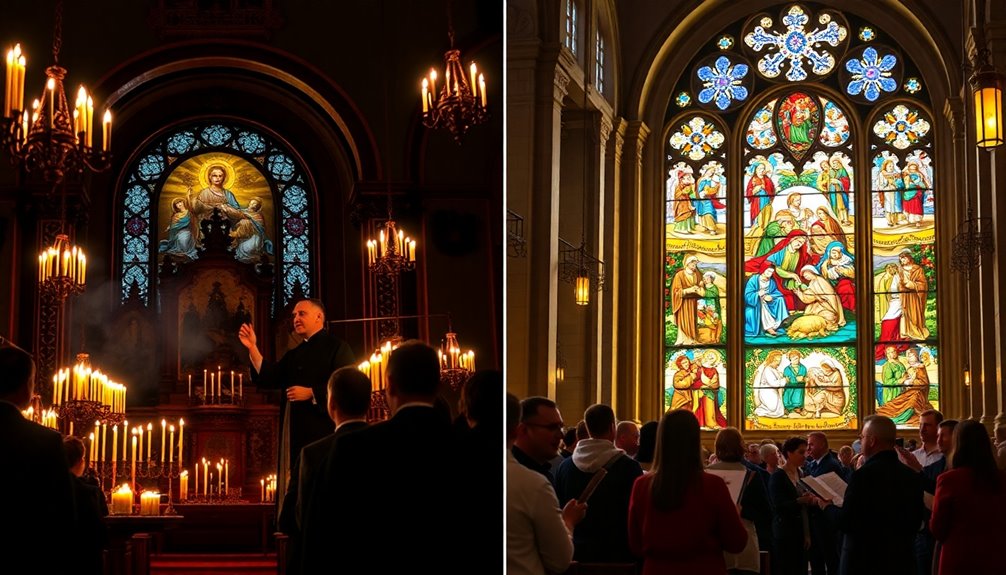
Although both Orthodox and Catholic Christmas celebrations center around the birth of Christ, their worship practices differ considerably.
In Orthodox Christmas, you'll experience a single, communal liturgy that emphasizes unity, unlike Catholic Christmas, which features three distinct masses.
Key differences include:
- Service Structure: Orthodox services combine multiple elements into one, while Catholics celebrate with separate events.
- Liturgy Focus: Orthodox worship highlights the Nativity with specific Old Scriptures readings, while Catholic services blend spiritual and familial themes.
- Attendance Patterns: Attendance during Orthodox Christmas is heightened but remains lower than Easter, contrasting with the more consistent turnout for Catholic masses.
- Theological Emphasis: Orthodox worship centers solely on the spiritual significance of Christ's birth, creating a profound atmosphere of reverence.
Regional Variations
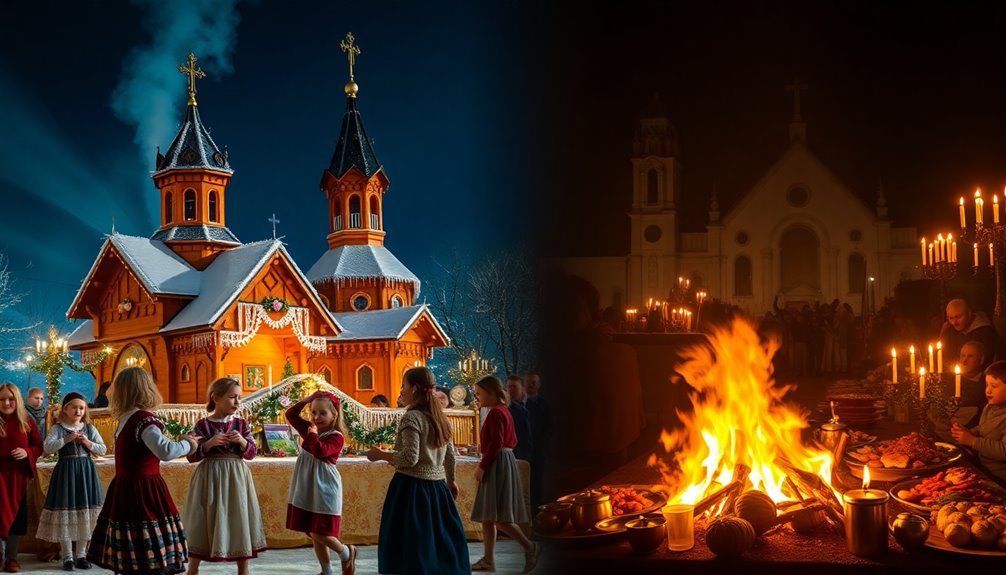
Regional variations in Christmas celebrations highlight the rich diversity within Orthodox traditions.
In Bulgaria and Greece, the Epiphany includes a unique custom where priests throw crucifixes into water, symbolizing Jesus' baptism.
Meanwhile, in the Western Balkans, families chop and ceremonially burn the Badnjak, a section of an oak tree, on Christmas Eve to represent the warmth and light of the holiday.
In Ukraine, the period from January 6 to 19 features vertep, a nativity-themed puppet theater performance that showcases local interpretations of the Christmas story.
Food customs also vary; for instance, Ukrainians often serve kutia, a special porridge-like dish, on Christmas Eve.
These regional variations reflect a blend of customs from both Christian and pre-Christian traditions within the Orthodox Church.
Cultural Significance

Cultural significance permeates Orthodox Christmas celebrations, where the emphasis on community and family gatherings strengthens the bonds among Eastern Christians. This holiday reflects deep-rooted traditions and values that enhance spiritual preparation and cultural identity.
- The extensive fasting period prior to Christmas showcases a commitment to spiritual growth.
- Traditional foods, including twelve dishes on Christmas Eve, symbolize the apostles and highlight local heritage.
- Unique regional customs, like the vertep puppet theater in Ukraine, blend Christian and pre-Christian elements.
- The greeting "Christ is born!" followed by "Glory to Him!" underscores the holiday's spiritual focus, setting it apart from more secular celebrations.
These elements create a rich tapestry of meaning that connects individuals to their heritage and community during Orthodox Christmas.
Festive Traditions
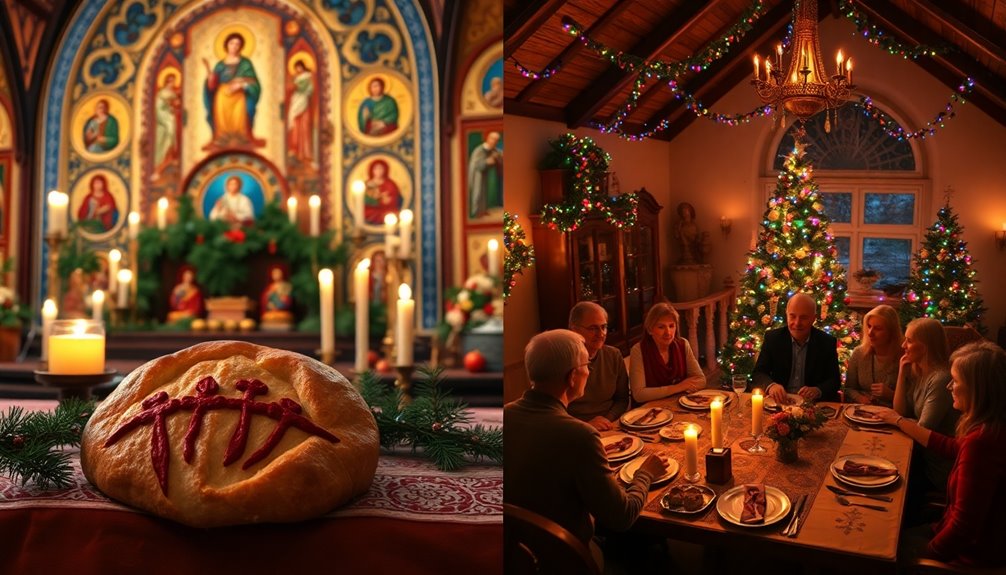
When you explore the festive traditions of Orthodox and Catholic Christmas, you'll notice some striking differences.
While Orthodox families fast until the first star appears, Catholics enjoy a variety of lean dishes on Christmas Eve.
Plus, the types of foods served and the ways gifts are exchanged reveal unique cultural flavors that shape each celebration.
Christmas Eve Customs
As you immerse yourself in the festive traditions of Christmas Eve, you'll notice that Orthodox and Catholic customs offer distinct yet meaningful experiences.
While Catholics celebrate with a festive meal, Orthodox Christians practice fasting until the first star appears, symbolizing Christ's birth.
Key differences include:
- Orthodox Christmas Eve features a traditional meal of 12 dishes, representing the apostles.
- The first star on December 24 is significant for Catholics, marking the start of their evening.
- Kutia, a porridge-like dish, is a staple during Orthodox celebrations.
- Caroling among Orthodox Christians often involves visiting multiple homes, unlike the more intimate Catholic gatherings.
These customs reflect the unique paths each faith follows within their liturgical calendar, enriching the Christmas experience.
Traditional Foods Served
Traditional foods served during Christmas Eve and Day reflect the rich heritage of both Orthodox and Catholic celebrations.
On Orthodox Christmas Eve, you'll enjoy a meal featuring 12 lean dishes, symbolizing the apostles, with Kutia—a sweet porridge made from wheat, honey, and poppy seeds—being a staple.
In contrast, Catholic Christmas Eve dinners highlight lean dishes like vegetable salads and fish, focusing on health and prosperity.
When Christmas Day arrives, Orthodox Christians serve hearty meat dishes such as roast suckling pig or goose, while Catholics also include various meats but lean towards lighter fare.
This diversity in traditional foods showcases local customs and agricultural practices, enriching both celebrations with unique flavors and meanings.
Gift-Giving Practices
While many people enthusiastically anticipate the joy of gift-giving during the holiday season, the practices surrounding this custom differ greatly between Orthodox and Catholic Christmas celebrations.
For Orthodox Christians, gift-giving typically occurs on St. Nicholas Day (December 19) or New Year's Eve (December 31) rather than Christmas Day. This shift emphasizes spiritual aspects over material gifts.
In contrast, the Catholic Church encourages exchanging gifts on Christmas Day, celebrating the spirit of giving.
Key differences include:
- Orthodox Christians prioritize spiritual connections on Christmas.
- Gifts are often exchanged on St. Nicholas Day.
- New Year's Eve gifts stem from communist influences.
- Catholic traditions center on Christmas Day gift exchanges.
These customs reflect broader cultural and theological distinctions between the two celebrations.
Frequently Asked Questions
What Is the Difference Between Catholic Christmas and Orthodox Christmas?
When you compare Catholic Christmas and Orthodox Christmas, you'll notice key differences.
Catholics celebrate on December 25, while Orthodox Christians observe it on January 6-7.
The meals vary too; Orthodox traditions feature 12 dishes on Christmas Eve, while Catholics often enjoy fish and salads.
Gift-giving also differs, with Catholics exchanging presents on Christmas Day, while Orthodox Christians typically wait until St. Nicholas Day or New Year's Eve.
Fasting practices are more rigorous in Orthodox traditions.
Is Orthodox Christmas on January 6 or 7?
Orthodox Christmas is celebrated on January 6 or 7, depending on the specific church. Most Orthodox Christians observe it on January 7, while some, like the Ukrainian Greek Catholic Church, celebrate it on January 6.
This difference arises from the use of the Julian calendar, which is currently 13 days behind the Gregorian calendar that Catholics use.
What Is the Main Difference Between Catholic and Orthodox?
The main difference between Catholic and Orthodox traditions lies in their liturgical practices and calendars.
You'll notice that Catholics follow the Gregorian calendar, celebrating key events like Christmas on December 25.
In contrast, Orthodox Christians adhere to the Julian calendar, often celebrating these same events later.
Additionally, their fasting periods and the significance placed on various rituals can vary, impacting how you experience the spiritual journey of each faith.
How Is Christmas Celebrated in the Orthodox Church?
In the Orthodox Church, you celebrate Christmas with a 40-day fasting period leading up to the event.
On Christmas Eve, you fast until the first star appears, then enjoy a meal of 12 traditional dishes, symbolizing the apostles. You attend a special liturgy called The Paramony, filled with Old Scriptures readings.
On Christmas Day, festive meals often include roast meats, and caroling is a cherished custom where children spread joy through song.
Conclusion
In the end, whether you're celebrating Orthodox or Catholic Christmas, both traditions shine like two sides of the same coin. Each brings unique customs and heartfelt meanings that enrich the holiday season. Embracing these differences can deepen your appreciation for the diverse ways people honor this joyous time. So, whether you're lighting candles or singing carols, remember that the essence of love and togetherness weaves through every celebration, making the world a little brighter.
